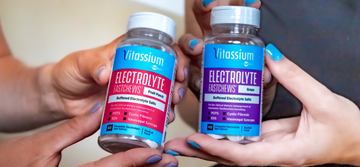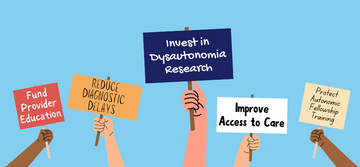
This article is written for educational purposes only and should not be construed as medical advice. If you are experiencing symptoms of Long COVID or dysautonomia, including chronic fatigue, lightheadedness, rapid heartbeat after standing or minimal movement, and/or brain fog, talk to your doctor.
This article was last updated on August 30, 2022.
In February 2020, Amanda’s husband fell ill after traveling for work, complaining of a high fever and trouble breathing. Four days later, Amanda got sick as well.
With concerns of the novel SARS-Cov-2 virus spreading rapidly, their primary care physician refused to see them, so they found themselves in an emergency room. All tests for strains of the flu and strep throat were negative.
They were never tested for the novel coronavirus as testing kits were extremely limited at that time, but Amanda had little doubt she and her husband were early COVID-19 patients. She had all the symptoms: fever, trouble breathing, loss of taste and smell, extreme fatigue.
Her husband’s situation improved. Hers didn’t.
“At the end of March, I unfortunately was developing new symptoms that were very strange – tachycardia, passing out when I stood up, allergies to foods I had always ate and strong aversion to any smells,” Amanda said. “After I gained my sense of smell back, it seemed that all smells were just too strong, especially anything that contained a synthetic fragrance.”
She also seemed to be constantly dehydrated. Blood work indicated low sodium levels, but her doctor couldn’t offer a cause for these long-lasting symptoms, suggesting she may just be imagining them.
Amanda refused to accept this conclusion. Her mom, a nurse practitioner, said her symptoms sounded like POTS (Postural Orthostatic Tachycardia Syndrome) and told her to try and meet with a cardiologist. Amanda did, and one tilt table test later, she received her diagnosis. It was POTS, likely triggered as an autoimmune response to her probable COVID-19 infection, the doctor said.
What Is Dysautonomia?
To anyone living with autonomic nervous system disorders, or dysautonomia, Amanda’s story may feel familiar – from her symptoms to her setbacks in the diagnosis process.
Thought to affect more than 70 million people worldwide, dysautonomia is a medical term that represents a malfunction of the autonomic nervous system. This system controls the “automatic” functions of the body that we do not consciously think about, such as heart rate, blood pressure, digestion, dilation and constriction of the pupils of the eye, kidney function and temperature control. People living with various forms of dysautonomia have trouble regulating these systems, which can result in lightheadedness, fainting, unstable blood pressure, abnormal heart rates and malnutrition.
There are several forms of dysautonomia, including POTS, as well as Neurocardiogenic Syncope (Vasovagal Syncope), Inappropriate Sinus Tachycardia (IST) and Multiple System Atrophy.
Despite the high prevalence of dysautonomia, most patients take years to get diagnosed due to a lack of awareness among the public and within the medical profession. For instance, 59% of POTS patients were told by a doctor that their symptoms were “all in your head” before receiving their diagnosis, according to Dysautonomia International.
Dysautonomia can have multiple causes, but viral infection is a known trigger.
Long COVID
Although many people quickly recover from COVID-19, others may experience residual symptoms months after contracting the virus. A 2021 study indicates that most COVID-19 patients have mild symptoms and recover within several weeks, but more than 50% are left with at least one ongoing symptom several months later. Other research indicates the proportion of COVID-19 patients who go on to develop Long COVID might be lower, but results are still inconclusive.
While researchers are still determining the cause of these long-term symptoms (patients dubbed “long haulers”), some of these Long COVID symptoms may actually be caused by autonomic nervous system disorders, or dysautonomia.
Symptoms can vary widely, but most often include chronic fatigue, brain fog and orthostatic intolerance (dizziness, lightheadedness, or blurred vision upon assuming upright posture).
As an umbrella term, there is no single “dysautonomia.” Often Long COVID is compared to one of the most common forms of dysautonomia – POTS – due to orthostatic intolerance. That said, research is still preliminary, and many studies have examined small groups of patients with minimal diversity. This means there is still a lot we don’t know, and it’s too early to draw conclusions about what’s going on with COVID-related dysautonomia – or standardized treatment guidelines. (Even when researching this article, our team noticed terms like “POTS” or “dysautonomia” were used in different ways, depending on the article.)
Some studies have suggested that patients with Long COVID-related orthostatic intolerance can benefit from liberal intake of water and salt – just like other forms of POTS. Some physicians also prescribe beta-blockers. However, there is no official treatment protocol as defined by the CDC as of August 2022.
What to do if you are experiencing long-lasting COVID symptoms
If you or someone you know has experienced COVID-19 and now have ongoing symptoms including:
- Severe fatigue
- Lightheadedness
- Brain fog or problems with memory
- Headaches
- Palpitations or changes in your heart rate with minimal or mild physical activity
- Chronic nausea and vomiting
You should discuss this with your doctor. First, your doctor should try to rule out other complications that may cause similar dysautonomia symptoms but that would require very different treatments. Then, talk to your doctor about dysautonomia and performing orthostatic vitals (laying, sitting and standing blood pressure, heart rate and oxygen levels) as the first steps to a diagnosis.
Remember, it’s NOT all in your head! Although awareness is improving, conditions like POTS are often misunderstood by healthcare providers, and can unfortunately be dismissed as anxiety. But if you’ve had significant physical changes in the way your body feels and behaves, whether due to COVID-19 or not, it’s important that you seek treatment. These tips from the CDC can help you explain your symptoms to your doctor.
If you obtain a diagnosis, there is no one-size-fits-all approach to treatment; however, your doctor may advise you to significantly increase salt and fluid intake. Vitassium was designed specifically to help you get the sodium and potassium you need, in whatever format works best for you. Learn about Vitassium here.
What’s next?
There is still a lot more research that needs to be done around Long COVID and its similarities to forms of dysautonomia like POTS. According to the CDC, as many as 1 in 13 U.S. adults have Long COVID symptoms – meaning there is an urgent need to find solutions. Perhaps a silver lining of the rise in Long COVID is a greater spotlight on, and funding for, research being done by organizations like Dysautonomia International.
For Amanda, it means taking things one day at a time. “I still have symptoms of POTS but not as severe,” she told us in November 2020 – nine months after her initial infection. “I am able to walk my dogs and go to the store without being scared if I will pass out.”
“Some days I just feel so fatigued and tired of fighting, but I keep going somehow,” she said. “I am not giving up.”
Disclaimer: Contact your physician before starting any exercise program or if you are taking any medication. Individuals with high blood pressure should also consult their physician prior to taking an electrolyte supplement. Overdose of electrolytes is possible, with symptoms such as vomiting and feeling ill, and care should be taken not to overdose on any electrolyte supplement.







